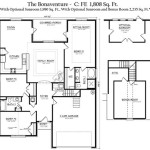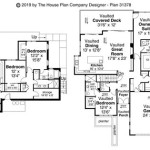
Finding the floor plan for your house can provide valuable insights into the layout and structural details of your property. A floor plan is a scaled drawing that represents the layout of a building, showing the arrangement of rooms, windows, doors, and other architectural features. It provides a comprehensive overview of the space, allowing you to visualize the flow and functionality of your home.
Floor plans are commonly used in a variety of scenarios, such as when making renovations, planning additions, troubleshooting plumbing or electrical issues, or simply understanding the spatial relationships within the house. Accurate floor plans can also be helpful for insurance purposes, property valuation, or even interior design projects.
In the following sections, we will explore the benefits of having access to your house floor plan, discuss various methods for obtaining it, and provide tips for interpreting and using it effectively.
Having access to your house floor plan offers numerous advantages:
- Understand home layout
- Plan renovations accurately
- Troubleshoot maintenance issues
- Enhance home security
- Optimize interior design
- Assist insurance assessments
- Support property valuations
- Facilitate home sales
- Preserve historical documentation
Obtaining and utilizing your house floor plan can greatly benefit homeowners, contractors, and real estate professionals alike.
Understand home layout
Access to your house floor plan provides a detailed visual representation of your home’s layout. It allows you to see the arrangement of rooms, hallways, windows, doors, and other structural elements, giving you a clear understanding of the spatial relationships within your property.
- Room dimensions and placement:
The floor plan will show you the precise dimensions of each room, including its length, width, and height. It will also indicate the location of walls, doors, and windows, allowing you to visualize the flow of space and how the rooms connect to each other.
- Wall and door configuration:
The floor plan will provide details about the placement and dimensions of walls, as well as the location and size of doors. This information is crucial for planning renovations, as it helps you determine if load-bearing walls need to be modified or if new doorways can be added.
- Window placement and dimensions:
The floor plan will show the location and size of all windows in your home. This information is important for understanding natural light patterns and ventilation, as well as for planning window replacements or additions.
- Structural elements:
The floor plan may also include information about structural elements such as beams, columns, and load-bearing walls. Understanding the location and orientation of these elements is essential for any major renovations or additions.
By studying the floor plan, you can gain a comprehensive understanding of your home’s layout, which can be invaluable for a variety of purposes, including planning renovations, troubleshooting maintenance issues, enhancing home security, optimizing interior design, and more.
Plan renovations accurately
A floor plan is an essential tool for planning renovations, as it provides a detailed and accurate representation of your home’s layout. By studying the floor plan, you can visualize the changes you want to make and ensure that they are feasible within the existing structure.
Here are some specific ways in which a floor plan can help you plan renovations accurately:
- Verify measurements and space constraints:
The floor plan will provide you with precise measurements of each room and structural element. This information is crucial for ensuring that your renovation plans are realistic and that you have enough space to accommodate the changes you want to make.
- Identify load-bearing walls and structural elements:
The floor plan will indicate the location of load-bearing walls and other structural elements. It is important to understand which walls can be removed or modified, and which ones need to remain in place to support the structure of your home.
- Plan electrical and plumbing upgrades:
If your renovations involve electrical or plumbing upgrades, the floor plan will help you determine the best locations for new outlets, switches, and fixtures. It will also help you identify any potential conflicts with existing wiring or plumbing.
- Visualize the flow of space:
The floor plan will allow you to see how the changes you are planning will affect the flow of space in your home. You can experiment with different layouts and room configurations to find the one that best meets your needs and preferences.
By carefully studying and utilizing your floor plan, you can increase the accuracy and efficiency of your renovation planning, which can save you time, money, and headaches in the long run.
Troubleshoot maintenance issues
A floor plan can also be a valuable tool for troubleshooting maintenance issues in your home. By referencing the floor plan, you can quickly identify the location of specific features and components, which can help you diagnose and resolve problems more efficiently.
- Identify the source of plumbing leaks:
If you have a plumbing leak, the floor plan can help you locate the source of the problem. By looking at the layout of the pipes and fixtures, you can trace the path of the water flow and identify the point where the leak is occurring.
- Troubleshoot electrical issues:
Similarly, the floor plan can help you troubleshoot electrical issues. By identifying the location of electrical outlets, switches, and wiring, you can more easily identify the source of a problem and determine the best course of action for resolving it.
- Locate hidden structural problems:
In some cases, a floor plan can help you identify hidden structural problems that may not be immediately apparent. For example, if you notice cracks in the walls or floors, the floor plan can help you determine if there are any underlying structural issues that need to be addressed.
- Plan maintenance and repairs:
Once you have identified the source of a maintenance issue, the floor plan can help you plan the necessary repairs. By understanding the layout of your home and the location of the affected components, you can determine the best way to access and repair the problem.
Having access to your house floor plan can greatly simplify the process of troubleshooting and resolving maintenance issues, which can save you time and money in the long run.
Enhance home security
A floor plan can be a valuable tool for enhancing the security of your home. By understanding the layout of your property and identifying potential vulnerabilities, you can take steps to mitigate risks and protect your family and belongings.
One way to use a floor plan for security purposes is to identify potential entry points for intruders. By studying the floor plan, you can identify areas where windows or doors are easily accessible or hidden from view. You can then take steps to secure these areas by installing locks, alarms, or other security measures.
Another way to use a floor plan for security is to plan escape routes in case of an emergency. In the event of a fire or other disaster, it is crucial to have a clear understanding of the exits in your home and the best way to evacuate. By studying the floor plan, you can identify the safest and most efficient escape routes for each room in your house.
Finally, a floor plan can be useful for documenting the location of valuables in your home. By marking the location of expensive items such as jewelry, electronics, or artwork on the floor plan, you can create a record that can be used for insurance purposes or to assist law enforcement in the event of a burglary.
By utilizing your house floor plan for security purposes, you can proactively identify and address potential vulnerabilities, enhance the safety of your family and belongings, and give yourself peace of mind.
Optimize interior design
A floor plan is an essential tool for optimizing the interior design of your home. By understanding the layout of your space and the relationship between different rooms, you can create a cohesive and functional design that meets your needs and preferences.
- Plan furniture placement:
The floor plan allows you to visualize the placement of furniture and other objects within your home. You can experiment with different arrangements to find the ones that maximize space utilization, create a comfortable flow of movement, and enhance the overall aesthetic appeal of each room.
- Choose appropriate furniture sizes:
The floor plan helps you determine the appropriate size and scale of furniture for each room. By understanding the dimensions of the space, you can avoid choosing furniture that is too large or too small, ensuring that your home feels balanced and well-proportioned.
- Maximize natural light:
The floor plan can help you identify the best ways to maximize natural light in your home. By understanding the location of windows and doors, you can position furniture and other objects to take advantage of natural light sources and create a brighter and more inviting atmosphere.
- Create focal points:
A floor plan can help you identify potential focal points within each room. These focal points can be architectural features, such as a fireplace or bay window, or they can be created through the strategic placement of furniture or artwork. By understanding the layout of your space, you can create a visually appealing and dynamic interior design.
By utilizing your house floor plan for interior design purposes, you can create a home that is both beautiful and functional, perfectly tailored to your individual taste and lifestyle.
Assist insurance assessments
A floor plan can also be a valuable tool for assisting insurance assessments in the event of a disaster or property damage. By providing a detailed and accurate representation of your home’s layout and contents, a floor plan can help insurance adjusters quickly and accurately assess the extent of the damage and determine the appropriate compensation.
- Document the condition of your home before a disaster:
Taking photos or videos of your home and its contents, and creating a detailed floor plan, can provide valuable documentation of the condition of your property before a disaster strikes. This documentation can be used to support your insurance claim and ensure that you receive the full amount of compensation you are entitled to.
- Identify and locate damaged areas after a disaster:
If your home is damaged in a disaster, a floor plan can help you quickly identify and locate the affected areas. This can help you prioritize repairs and make temporary arrangements for your family’s safety and comfort.
- Provide evidence of lost or damaged belongings:
By marking the location of your belongings on the floor plan, you can create a record of your possessions and provide evidence of any items that were lost or damaged during the disaster. This information can be crucial for supporting your insurance claim and ensuring that you are fairly compensated for your losses.
- Facilitate the claims process:
Having a floor plan readily available can streamline the insurance claims process. By providing insurance adjusters with a clear and comprehensive overview of your home’s layout and contents, you can help them assess the damage and determine the appropriate compensation more quickly and efficiently.
By utilizing your house floor plan for insurance purposes, you can ensure that you are fully compensated for any losses or damages in the event of a disaster, and that the claims process is handled smoothly and efficiently.
Support property valuations
A floor plan can also be a valuable tool for supporting property valuations. By providing a detailed and accurate representation of your home’s layout and features, a floor plan can help appraisers accurately assess the value of your property and ensure that you receive a fair market value.
- Provide accurate measurements and dimensions:
A floor plan provides precise measurements and dimensions of each room and structural element in your home. This information is crucial for appraisers to determine the square footage and overall size of your property, which are key factors in determining its value.
- Document unique features and amenities:
A floor plan can help you document unique features and amenities that add value to your home, such as a finished basement, a gourmet kitchen, or a home office. These features can be difficult to quantify, but a floor plan provides visual evidence of their existence and quality.
- Highlight recent renovations and upgrades:
If you have recently made renovations or upgrades to your home, a floor plan can help you highlight these improvements to potential buyers or appraisers. By showing the before and after plans, you can demonstrate the increased value that these renovations have added to your property.
- Facilitate virtual property tours:
In today’s digital age, floor plans are often used to create virtual property tours. These tours allow potential buyers or appraisers to view the layout and features of your home remotely, which can be especially useful for properties that are difficult to access or for out-of-town buyers.
By utilizing your house floor plan for property valuation purposes, you can ensure that your home is accurately and fairly valued, maximizing your return on investment and ensuring that you receive the best possible price when you sell.
Facilitate home sales
A floor plan can be a powerful tool for facilitating the sale of your home. By providing potential buyers with a clear and comprehensive overview of your home’s layout and features, a floor plan can make your property more attractive and easier to sell.
- Showcase your home’s best features:
A well-designed floor plan can showcase your home’s best features and highlight its strengths. By emphasizing spacious rooms, natural light, and a functional layout, you can create a visually appealing presentation that will capture the attention of potential buyers.
- Provide buyers with a clear understanding of the layout:
A floor plan gives potential buyers a clear understanding of the layout of your home, allowing them to easily visualize the flow of space and the relationship between different rooms. This can be especially helpful for buyers who are viewing your home online or from a distance.
- Make your home stand out from the competition:
In a competitive real estate market, it is important to make your home stand out from the competition. A professional floor plan can give your listing a polished and professional appearance, making it more likely to attract the attention of potential buyers.
- Increase buyer confidence:
A floor plan can increase buyer confidence by providing them with a clear understanding of what they are buying. By seeing the layout and dimensions of each room, buyers can make more informed decisions and feel more confident in their purchase.
By utilizing your house floor plan for home sales purposes, you can make your property more attractive to potential buyers, increase buyer confidence, and ultimately sell your home faster and for a better price.
Preserve historical documentation
Floor plans can serve as valuable historical documents, providing insights into the architectural design and evolution of a property over time. Preserving floor plans can contribute to the historical record of a building and its significance within its community.
- Document architectural heritage:
Floor plans capture the architectural heritage of a building, showcasing its design, style, and construction methods. They provide a visual record of the building’s original intent and can be used to understand how the building has been modified or expanded over time.
- Facilitate restoration and preservation efforts:
Accurate floor plans are essential for restoration and preservation efforts. By providing detailed information about the building’s layout, materials, and structural elements, floor plans guide architects and contractors in restoring the building to its original condition or preserving its historical character.
- Support research and documentation:
Floor plans can be used by historians, architects, and researchers to study the evolution of building design and construction practices. They provide valuable data for understanding how buildings have responded to changing social, economic, and technological conditions.
- Enhance the historical narrative of a property:
Floor plans can enrich the historical narrative of a property by providing visual evidence of its past occupants and uses. By overlaying floor plans from different periods, it is possible to trace the changes that have occurred over time and gain a deeper understanding of the building’s history and significance.
Preserving floor plans is an important aspect of documenting and safeguarding the architectural and historical value of buildings. By providing a detailed and accurate record of a building’s layout and design, floor plans contribute to the collective understanding of our built environment and preserve the legacy of our architectural heritage.






:max_bytes(150000):strip_icc()/floorplan-138720186-crop2-58a876a55f9b58a3c99f3d35.jpg)


Related Posts








